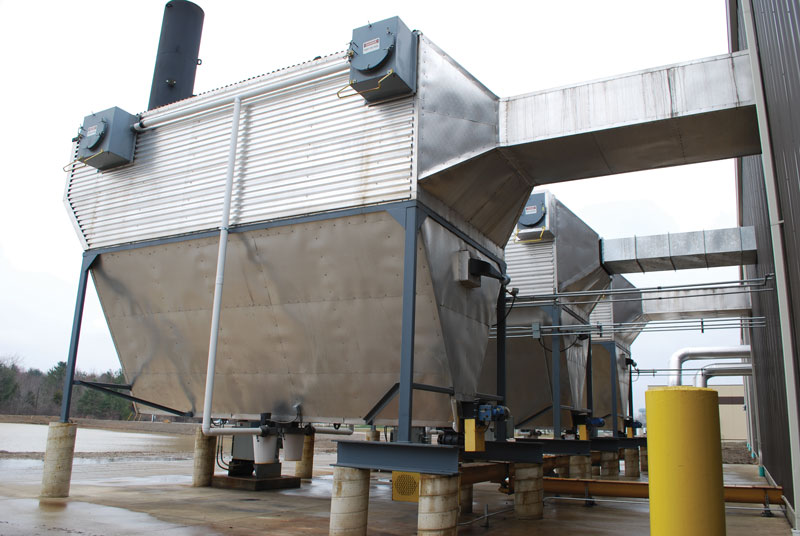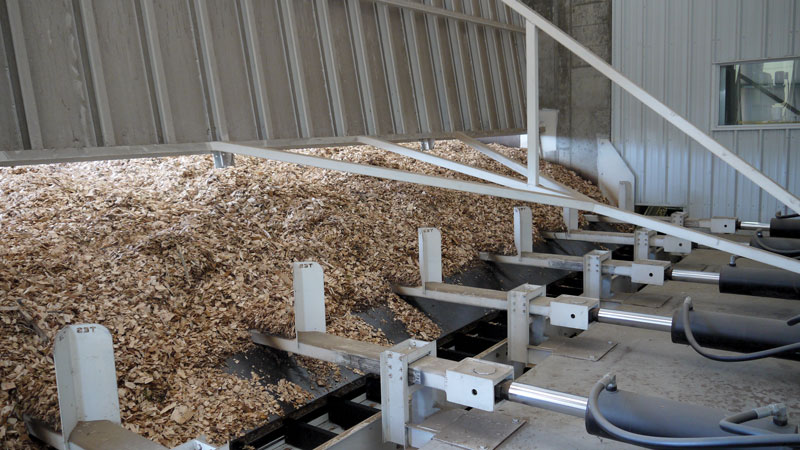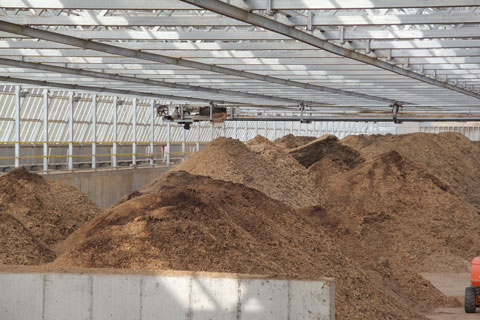2/1/2018
Biomass: An Update
Jennifer Zurko
During the Recession, oil prices skyrocketed, forcing many growers to re-think how they were going to heat their greenhouses. But when a down economy gives you lemons, the sustainability movement helps you make lemonade. Enter alternative fuel.
Solar power is a common and relatively inexpensive option … if you live in a sunny location. Geothermal is an interesting concept … if you’re above a hot spring or geothermal hot spot. Installing a biomass boiler … for some growers, that was a more realistic option and it’s become a reliable tool that was worth the investment.
We checked in with a few operations that installed biomass boilers during the Recession to see how they’ve worked for them and whether they would still do it again, even today, when the economy and energy costs are faring a bit better.

Green Circle Growers—Oberlin, Ohio
This Midwest grower installed their biomass boiler in 2009 primarily because of the cost of natural gas at the time (in 2008, the cost of natural gas was $15.90 per 1,000 cu. ft., according to the U.S. Energy Information Administration).
The cost of the wood for the boiler fluctuates—it can be anywhere from $400 to $900 a truckload. But since they’ve installed the biomass boiler system, Green Circle has seen an overall fuel cost reduction of about $1 million in less than 10 years.
Pictured: Green Circle Growers’ Vyncke biomass boiler heats the entire facility, including all of the greenhouses and the office space.
The cost savings alone aren’t the only benefits they’ve experienced with biomass. Dave Bring, assistant maintenance manager for Green Circle, said that the system heats their entire facility, which is 108 acres under cover, along with all of their office space. Dave said it’s also nice to use an eco-friendly, sustainable system.
Also, the system itself has proven to be relatively low-maintenance. Besides having to do some general care—like greasing and checking the chains weekly, and cleaning out the boilers daily—there haven’t been any major challenges with it.
Dave said that they source the wood from about 12 to 15 different vendors, including tree services and recyclers of pallets and even old houses that have recently been torn down. The reason why the number of vendors varies is because the availability of wood varies by season. During the really frigid temperatures of winter, they usually don’t see any deliveries.
The folks at Green Circle Growers are pleased with their biomass boiler and believe it is a viable way to heat the greenhouse, but it didn’t totally replace their natural gas boilers. There are times when they’ll use natural gas if it’s running cheaper than wood at the time, said Dave. And during severe cold, they will sometimes run all of the biomass boilers along with the natural gas boilers.
But if times weren’t tough in 2009, would they have still done it? It depends, said Dave.
“Depends on the natural gas price at the time versus the cost of wood,” he explained. “Since fuel prices fluctuate, it’s hard to say definitively that one is superior on any given day. But for sustainability, we’re happy with our decision to invest in a more eco-friendly option that allows us to recycle.”

Pleasant View Gardens—Loudon, New Hampshire
This New England grower has two facilities and installed biomass boiler systems at both—the first one at the Pembroke location in 2011 and the other in Loudon a year later.
They had been investigating the possibility of using alternative fuel for a while—about 10 years. It was difficult to come to a decision because they were in the middle of expansion projects at the same time, replacing old Quonsets with new greenhouses. And they knew if they did move forward with a biomass boiler, they would have to centralize their entire heating system, which was a huge undertaking.
Pictured: Pleasant View uses “bole chips” as their biomass fuel because it’s a “cleaner chip” taken directly from the trunk and main branches of the tree, with less debris that can clog the system.
But then the economy crashed and fuel prices “started getting crazy,” said Henry Huntington, owner of Pleasant View Gardens. “So we knew we had to do something about it.”
They shopped around, tested a few out, and put in a Hurst boiler at the Pembrook location, which was about $2 million total. Yes, the price tag is high for a heating system, Henry said, but “the payoff was a no-brainer. Oil was over $4.00 a gallon and we worked out the calculations.” Henry estimates that with the biomass boilers, Pleasant View saves about $1 million a year in fuel costs.
And before biomass, oil and propane were Henry’s only options; being out in the sticks of New England, natural gas isn’t available, so they had to come up with a better, more cost-effective solution.
Their biomass boiler system is pretty automated, said Henry, so that’s it’s easier for them to maintain it and keep it running at peak performance. They’ve learned a lot over the years as they’ve been using it, too, like opting for a “cleaner chip,” called a “bole chip,” that comes from the trunk and main branches of the tree, which has less debris that can clog up the machine.
The wood comes from local managed woodlands where cut trees are replaced, so Henry said that he sees this type of fuel as being sustainable for at least the next 15 to 20 years.
“Biomass is great as long as you have the fuel,” he said. “The logging industry has changed fairly dramatically up here; there used to be paper mills everywhere and now they’re all gone. So right now, there’s a glut in the market for wood chips. And we’re actually paying less for chips per ton now than when we first started.”
Henry was able to pay back both boilers in three to four years. “For a capital expenditure, at that kind of cost of inputs, we still feel like it was well worth it,” said Henry. (As of now, their cut greens operation, lëf Farms, is only 1 acre, so Henry doesn’t feel it would be worth installing a biomass boiler for this part of the business.)
With all of the money invested in researching and planning, reconstructing their heating system, and building a storage facility and a smokestack, Henry said that without the biomass boiler, he’s not sure they would’ve been able to stay afloat.
“The first few years, after we put it in, fuel prices were still sky high, and every time I looked at my financial statement, I thought, ‘How could we have even afforded paying for fuel oil at this point.’ We would have lost money,” he said. “So it certainly did what we wanted it to do.”

Metrolina Greenhouses—Huntersville, North Carolina
The year 2008, North Carolina was seeing natural gas costs between $12 and $16 a dekatherm, so by 2009, Metrolina’s biomass boiler system was already well underway. Thomas VanWingerden said that it was the best course of action at the time and is still the correct decision.
Although they can’t provide close estimates on fuel savings because they weren’t relying much on natural gas to begin with, Thomas said that with the biomass system, they’re dealing with a more stable fuel buying market. Plus, it’s “always good to be working with renewable energy,” he said.
Pictured: Thirty to 40% of the wood that Metrolina Greenhouses uses is from nearby Charlotte, North Carolina, recycled from pallets and building scrap wood. The rest comes from timber harvesters within a 60-mile radius.
Thirty to 40% of the wood they use is from nearby Charlotte, recycled from pallets and building scrap wood. The rest comes from timber harvesters within a 60-mile radius.
“With the growing economy and more construction projects going on, there is more than enough supply for our boilers,” said Thomas.
Thomas and Jeff Woosley, who supervises the Controls Department for Metrolina, said that since the boiler was installed, there have been no major challenges. Other than a bit of yearly maintenance from wear and tear and adding an extra return pump, there hasn’t been much else they’ve had to do to the system.
It was a large undertaking, and because of the size of their operation, Metrolina had to add a lot of space to house the boilers and wood chips. However, Jeff said it’s still very much a worthwhile investment and they rely on biomass to provide the majority of the heat for their greenhouses.
“Biomass heat is never more expensive than fossil fuels,” said Jeff. “We only use our regular boilers as emergency backup and supplemental heat, which is rarely needed.”
But Thomas cautions that the initial investment in a biomass boiler system is much greater than buying natural gas boilers, so if you’re considering switching fuel systems, you should look at the current costs of fuel before making a final decision.
“Yes, the fuel [for a biomass boiler] is cheaper, but the initial cost would probably make more business sense to buy gas boilers with the way the current market is today,” he said. GT